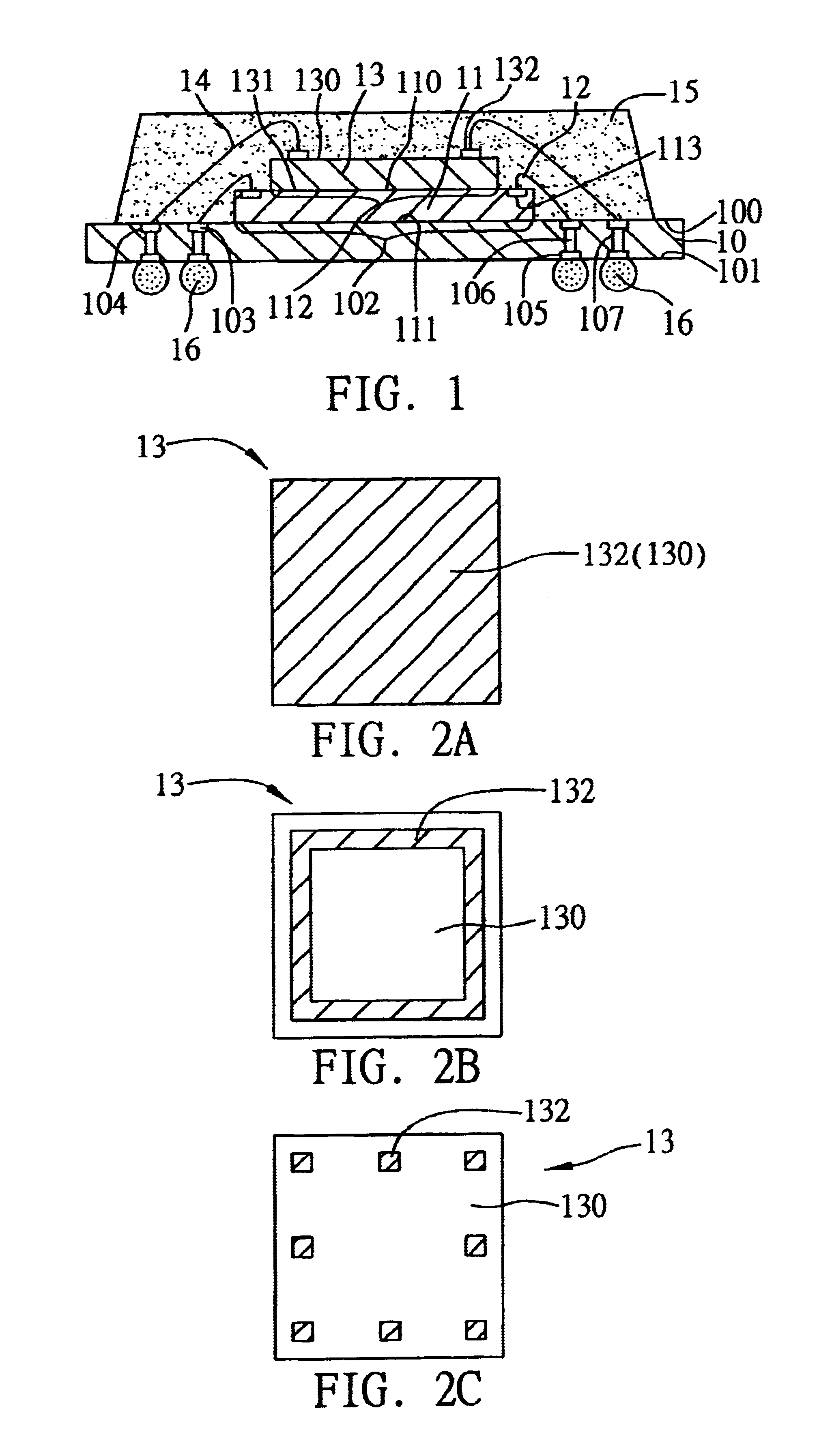Thermally enhanced semiconductor package with EMI shielding
a technology of shielding and semiconductors, applied in the direction of electrical equipment construction details, electrical device connections, lighting and heating apparatus, etc., can solve the problems of undetectable damage to the chip performance, heat produced by the chip is difficult to be dissipated, warpage and cracks, etc., to prevent warpage and cracks, reduce thermal stress, and ensure the structural integrity and yield of the fabricated semiconductor package
- Summary
- Abstract
- Description
- Claims
- Application Information
AI Technical Summary
Benefits of technology
Problems solved by technology
Method used
Image
Examples
first preferred embodiment
FIG. 1 illustrates a semiconductor package according to a first preferred embodiment of the invention. As shown in the drawing, this semiconductor package utilizes a substrate 10 as a chip carrier; the substrate 10 is primarily made of a conventional resin material such as epoxy resin, polyimide resin, BT (bismaleimide triazine) resin, FR4 resin, etc.
The substrate 10 has an upper surface 100 and a lower surface 101 opposed to the upper surface 100, wherein the upper surface 100 is defined with a chip attach area 102, a plurality of bond fingers 103 and a ground ring 104 surrounding the bond fingers 103 are formed outside the chip attach area 102, and a plurality of ball pads 105 are disposed on the lower surface 101 of the substrate 100. The substrate 10 is further formed with a plurality of conductive vias 106 and ground vias 107 penetrating therethrough, wherein the conductive vias 106 have one end thereof connected to the bond fingers 103 and the other end connected to the corres...
second preferred embodiment
FIG. 3 illustrates a semiconductor package according to a second preferred embodiment of the invention. This semiconductor package differs from that of the first embodiment in the way of electrical connection between the chip and substrate. As shown in FIG. 3, the active surface 110 of the chip 11 is mounted in a face-down manner on the chip attach area 102 and electrically connected to the upper surface 100 of the substrate 10 by a plurality of solder bumps 17, wherein the solder bumps 17 have one end thereof connected to a plurality of bond pads 108 formed on the chip attach area 102 and the other end connected to the bond pads 113 formed on the active surface 110 of the chip 11. Further, the conductive vias 106 formed through the substrate 10 have one end thereof connected to the bond pads 108 of the substrate 10 and the other end connected to the solder balls 16 implanted on the lower surface 101 of the substrate 10. This face-down arrangement of the chip electrically coupled to...
third preferred embodiment
FIG. 4 illustrates a semiconductor package according to a third preferred embodiment of the invention. This semiconductor package differs from that of the above second embodiment in that a surface of the thermally conductive member is exposed to outside of the chip-encapsulating encapsulant. As shown in FIG. 4, by the flip-chip arrangement of the chip 11 electrically connected to the substrate 10 via the solder bumps 17, a thermally conductive member 13 larger in surface area than the chip 11 can be used, wherein a recessed portion 133 of a step-like shape (not limited to this) is formed at peripheral area on the first surface 130 of the thermally conductive member 13, and the metal layer 132 is applied over the recessed portion 133 to be connected with bonding wires 14. The recessed portion 133 has a depth greater than a loop height of the bonding wires 14 protruding from the metal layer 132 to allow loops of the bonding wires 14 to be comfortably received with the recessed portion...
PUM
 Login to View More
Login to View More Abstract
Description
Claims
Application Information
 Login to View More
Login to View More - R&D
- Intellectual Property
- Life Sciences
- Materials
- Tech Scout
- Unparalleled Data Quality
- Higher Quality Content
- 60% Fewer Hallucinations
Browse by: Latest US Patents, China's latest patents, Technical Efficacy Thesaurus, Application Domain, Technology Topic, Popular Technical Reports.
© 2025 PatSnap. All rights reserved.Legal|Privacy policy|Modern Slavery Act Transparency Statement|Sitemap|About US| Contact US: help@patsnap.com



